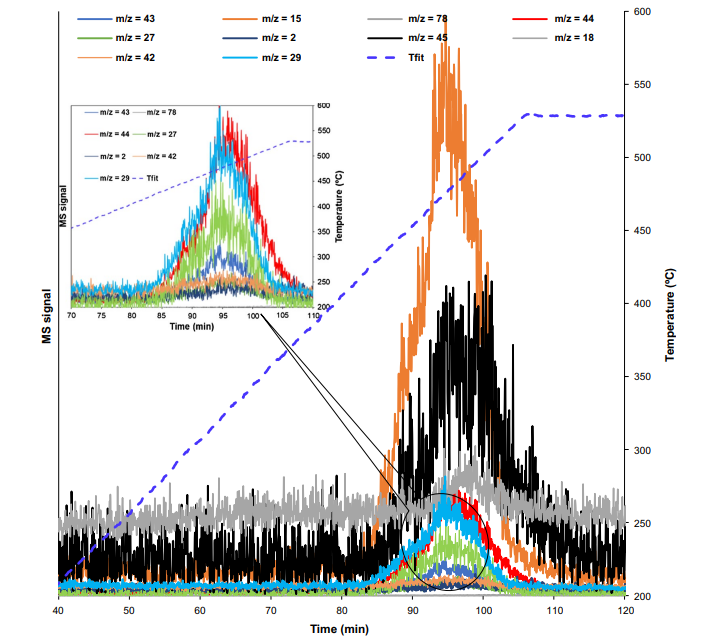Herein we studied the kinetic modelling of the pyrolysis process for one of the most common plastic wastes, such as polyethylene terephthalate (PET) as understanding the pyrolysis process and the degradation mechanism is crucial for scale-up and reactor design. The focus was to evaluate and predict PET pyrolysis when transitioning to a low-carbon economy and adhering to environmental and governmental legislation. This work has been published in Environmental Sciences Europe journal (I.F 5.4 and SNIP 2.2). This can be used by plastic recyclers worldwide and in the predictions to determine how the rate of reaction changes based on temperature and heating rate beyond experimental results both isothermally, non-isothermally and in stepwise heating regimes. Furthermore, we published a review on bioplastic production for food packaging published in Environmental Chemistry Letters, (2020) (I.F 5.93). Furthermore, one recent paper on the pyrolysis of mixed plastic waste studied the emissions related to such a process and the Life Cycle Assessment.

Mass spectrum profile of the evolved gaseous emissions during the PET pyrolysis under N2 atmosphere for temperature up to 530 °C with a heating rate of 5 °C min−1. The blue-dashed line represents the temperature recorded via the thermocouple
There are two outputs publications:
[1] A.I. Osman, C. Farrell, A.H. Al-Muhtaseb, A.S. Al-Fatesh, J. Harrison, D.W. Rooney, Pyrolysis kinetic modelling of abundant plastic waste (PET) and in-situ emission monitoring, Environmental Sciences Europe, 32 (2020) 112.
[2] U. Qasim, A.I. Osman, A.a.H. Al-Muhtaseb, C. Farrell, M. Al-Abri, M. Ali, D.-V.N. Vo, F. Jamil, D.W. Rooney, Renewable cellulosic nanocomposites for food packaging to avoid fossil fuel plastic pollution: a review, Environmental Chemistry Letters, (2020).
[3] Ahmed I. Osman, Ahmed M. Elgarahy, Neha Mehta, Alaa H. Al-Muhtaseb, Ahmed S. Al-Fatesh, David W. Rooney. Facile Synthesis and Life Cycle Assessment of Highly Active Magnetic Sorbent Composite Derived from Mixed Plastic and Biomass Waste for Water Remediation. ACS Sustainable Chemistry & Engineering (2022)
International collaboration:
Three videos were released from the project to increase public awareness of the plastic problem, with over 4.0 million views on social media. The plastic competition released from the project, the competition winner, visited Queen’s University Belfast and researched mixed low-value plastic recycling which led to a potential publication. Furthermore, we developed an application (app) in collaboration with EJUST (Egypt Japan University Of Science and Technology) where people in Egypt can post photos for the plastic waste in River Nile that were used to write a follow-up funding proposal entitled “Reducing the Impact of Plastic in Egypt and the Nile (RIPEN)” project with four ministries show interest in Egypt to be involved in the project, and this was officially disused and approved from the Prime Minister of Egypt.
 Project summary by: Dr Ahmed Osman, Research Fellow at School of Chemistry and Chemical Engineering |Queen’s University Belfast | David Keir Building| Belfast BT9 5AG.
Project summary by: Dr Ahmed Osman, Research Fellow at School of Chemistry and Chemical Engineering |Queen’s University Belfast | David Keir Building| Belfast BT9 5AG.
Paper Reference:Osman et al. “Pyrolysis kinetic modelling of abundant plastic waste (PET) and in-situ emission monitoring” Environmental Sciences Europe (2022) 32, 112 DOI: doi.org/10.1186/s12302-020-00390-x
Hiden Product: HPR-20
Download PDF: AP-HPR-20-202397_Egypt
To find out more about these products visit the HPR-20 product page or if you would like to contact us directly please Send us a Message.

